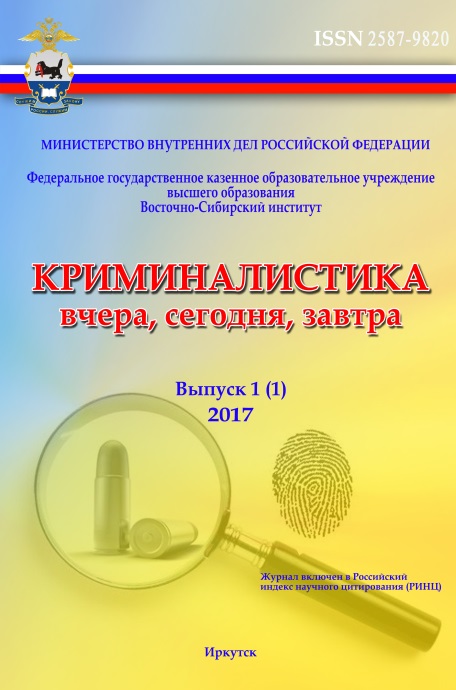from 01.01.2009 to 01.01.2023
Barnaul, Barkaul, Russian Federation
UDC 343.98
CSCSTI 10.85
Russian Library and Bibliographic Classification 6752
A forensic approach to the use of social engineering in the commission of high-tech crimes is formulated. Quantitative estimates of the scale and dynamics of the use of relevant technologies by criminals are given. The main causes and conditions conducive to the expanding use of social engineering techniques by criminals have been established and considered. The main technologies of social engineering used in the commission of high-tech crimes, aimed at both individuals and legal entities, are given. Attention is drawn to the special danger of attracting social engineering technologies by organized criminal groups. The problems of insidership and "involuntary complicity" in crimes committed with the help of social engineering have been studied. It is concluded that when committing high-tech crimes, social engineering technologies are used in combination with software and hardware and software, forming a single set of means of committing crimes, providing a qualitative leap in achieving a criminal result. The identified features of the application of social engineering technologies can be used in the development and implementation of forensic measures to counter high-tech crimes.
computer crimes, methods of committing crimes, means of committing crimes, phishing, information technologies
1. Mescheryakov V.A. Prestupleniya v sfere komp'yuternoy informacii: pravovoy i kriminalisticheskiy analiz. - Voronezh: Voronezhskiy gosudarstvennyy universitet, 2011. - 176 s.
2. Rossinskaya E.R. Koncepciya ucheniya ob informacionno-komp'yuternyh kriminalisticheskih modelyah kak osnove metodik rassledovaniya komp'yuternyh prestupleniy // Vestnik Vostochno-Sibirskogo instituta MVD Rossii. - 2021. - № 2 (97). - S. 190-200.
3. Polyakov V.V. Istochniki i principy formirovaniya chastnoy metodiki rassledovaniya vysokotehnologichnyh prestupleniy // Lex russica. - 2022. - T. 75. - № 6. - S. 85-96. DOIhttps://doi.org/10.17803/1729-5920.2022.187.6.085-096.
4. Bahteev D.V. O nekotoryh sovremennyh sposobah soversheniya moshennichestva v otnoshenii imuschestva fizicheskih lic // Rossiyskoe pravo: obrazovanie, praktika, nauka. - 2016. - № 3 (93). - S. 24-26.
5. Starostenko N.I. Kriminalisticheskiy aspekt tehnik social'noy inzhenerii pri sovershenii prestupleniy // Vestnik Krasnodarskogo universiteta MVD Rossii. - 2020. - № 1 (47). - S. 80-83.
6. Davydov, V.O., Tishutina I.V. Ob aktual'nyh problemah kriminalisticheskogo obespecheniya raskrytiya i rassledovaniya moshennichestv, sovershennyh s ispol'zovaniem informacionno-telekommunikacionnyh tehnologiy // Kriminalistika: vchera, segodnya, zavtra. - 2020. - № 2 (14). - S. 81-91.
7. Leukfeldt, E.R., Lavorgna A., Kleemans E.R. Organised Cybercrime or Cybercrime that is Organised? An Assessment of the Conceptualisation of Financial Cybercrime as Organised Crime. European Journal on Criminal Policy and Research. - 2017. - Vol. 23. - Iss. 3. - R. 287-300. https://doi.org/10.1007/s10610-016-9332-z.
8. Kruisbergen E.W., Leukfeldt E.R., Kleemans E.R., Roks R.A. Money talks money laundering choices of organized crime offenders in a digital age // Journal of Crime and Justice. - 2019. - Vol. 42, №. 5. - P. 569-581. https://doi.org/10.1080/0735648X.2019.1692420
9. Polyakov V.V. Struktura i soderzhanie sposoba soversheniya vysokotehnologichnyh prestupleniy // Rossiyskoe pravo: obrazovanie, praktika, nauka. - 2023. - № 1. - S. 27-39. DOIhttps://doi.org/10.34076/2410_2709_2023_1_27.
10. Osipenko A.L. Organizovannaya prestupnaya deyatel'nost' v kiberprostranstve: tendencii i protivodeystvie // Vestnik Nizhegorodskoy akademii MVD Rossii. - 2017. - № 4 (40). - S. 181-187.
11. Polyakov V.V. Latentnost' vysokotehnologichnyh prestupleniy: ponyatie, struktura, metody ocenki urovnya // Vserossiyskiy kriminologicheskiy zhurnal. - 2023. - T. 17, № 2. - S. 146-155. DOIhttps://doi.org/10.17150/2500-4255.2023.17(2).146-155.
12. Polyakov, V.V., Lapin S.A. Sredstva soversheniya komp'yuternyh prestupleniy // Doklady Tomskogo gosudarstvennogo universiteta sistem upravleniya i radioelektroniki. - 2014. - № 2 (32). - S. 162-166.
13. Avezova Ya. Aktual'nye kiberugrozy // Sbornik issledovaniy po prakticheskoy informacionnoy bezopasnosti. Positive Research, 2020. - S. 12-27. URL: https://www.ptsecurity.com/upload/corporate/ru-ru/analytics/positive-research-2020-rus.pdf. (data obrascheniya 13.06.2023).
14. Suhodolov, A.P., Bychkova A.M. Iskusstvennyy intellekt v protivodeystvii prestupnosti, ee prognozirovanii, preduprezhdenii i evolyucii // Vserossiyskiy kriminologicheskiy zhurnal. - 2018. - T. 12, № 6. - S. 753-766. DOI:https://doi.org/10.17150/2500-4255.2018.12(6).753-766.
15. Doronicheva, Yu., Babin Ya. Kiberchuma na vse vremena, ili neskol'ko sovetov po zaschite ot fishinga // Sbornik issledovaniy po prakticheskoy informacionnoy bezopasnosti. Positive Research, 2020. - S. 78-87. URL: https://www.ptsecurity.com/upload/corporate/ru-ru/analytics/positive-research-2020-rus.pdf. (data obrascheniya 13.06.2023).
16. Loggen, J., Leukfeldt R. Unraveling the crime scripts of phishing networks: an analysis of 45 court cases in the Netherlands // Trends in Organized Crime. - 2022. - Vol. 25. - P. 205-225. https://doi.org/10.1007/s12117-022-09448-z.
17. Truncevskiy Yu.V. Kiberprestupleniya v korporativnoy srede: riski, ocenka i mery preduprezhdeniya // Rossiyskiy sledovatel'. - 2014. - №21. - S. 19-21.
18. Levcov, V., Demidov N. Anatomiya targetirovannoy ataki. Chast' 2. Razvitie ataki // Sistemnyy administrator. - 2016. - № 5. - S. 16-21. URL: http://samag.ru/archive/article/3188. (data obrascheniya 13.06.2023).
19. Polyakov, V.V., Shiryaev A.V. Kriminalisticheskie aspekty lichnosti poterpevshih ot kiberprestupleniy // Ugolovno-processual'nye i kriminalisticheskie chteniya na Altae: Problemy i perspektivy protivodeystviya prestupleniyam, sovershaemym s primeneniem informacionnyh tehnologiy / Sbornik nauchnyh statey / otv. red. S.I. Davydov, V.V. Polyakov. - Barnaul: Izd-vo Alt. un-ta, 2018. - Vyp. XV. - S. 164-172.
20. Sabyrbaeva A.B. O merah po protivodeystviyu moshennichestvu (na primere fishinga) // Gosudarstvo i pravo. - 2021. - № 1. - S. 181-185. DOI:https://doi.org/10.31857/S102694520017465-2.
21. Williams, E.J., Joinson A.N. Developing a measure of information seeking about phishing // Journal of Cybersecurity. - 2020. - Vol. 6, №. 1. - R. 1-16. https://doi.org/10.1093/cybsec/tyaa001.












